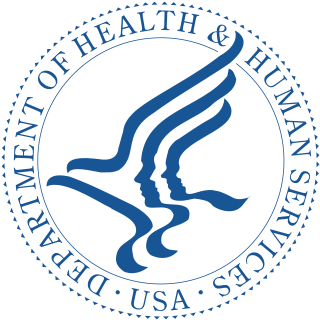
In medicine, triage is a process by which care providers such as medical professionals and those with first aid knowledge determine the order of priority for providing treatment to injured individuals and/or inform the rationing of limited supplies so that they go to those who can most benefit from it. Triage is usually relied upon when there are more injured individuals than available care providers, or when there are more injured individuals than supplies to treat them.

The United States Department of Health and Human Services (HHS) is a cabinet-level executive branch department of the U.S. federal government created to protect the health of the U.S. people and providing essential human services. Its motto is "Improving the health, safety, and well-being of America". Before the separate federal Department of Education was created in 1979, it was called the Department of Health, Education, and Welfare (HEW).
A trauma center, or trauma centre, is a hospital equipped and staffed to provide care for patients suffering from major traumatic injuries such as falls, motor vehicle collisions, or gunshot wounds. The term, "trauma center," may be used incorrectly to refer to an emergency department that lacks the presence of specialized services or certification to care for victims of major trauma.
The Strategic National Stockpile (SNS), originally called the National Pharmaceutical Stockpile (NPS), is the United States' national repository of antibiotics, vaccines, chemical antidotes, antitoxins, and other critical medical supplies. Its website states:
"The Strategic National Stockpile's role is to supplement state and local supplies during public health emergencies. Many states have products stockpiled, as well. The supplies, medicines, and devices for life-saving care contained in the stockpile can be used as a short-term stopgap buffer when the immediate supply of adequate amounts of these materials may not be immediately available."

A Disaster Medical Assistance Team (DMAT) is a specialized group under the National Disaster Medical System (NDMS), part of the U.S. Department of Health and Human Services. These teams are composed of professional medical personnel including physicians, physician assistants (PA), nurses, paramedics, pharmacists, and logistical and administrative support staff. DMATs are deployed to provide rapid-response medical care, support hospitals with excess patient loads, and engage in patient triage and emergency care during significant incidents such as natural disasters, terrorist attacks, disease outbreaks, and national special security events.

The National Disaster Medical System (NDMS) is a federally coordinated disaster medical system and partnership of the United States Departments of Health and Human Services (HHS), Homeland Security (DHS), Defense (DOD), and Veterans Affairs (VA). The purpose of the NDMS is to support State, local, Tribal and Territorial authorities following disasters and emergencies by supplementing health and medical systems and response capabilities. NDMS would also support the military and the Department of Veterans Affairs health care systems in caring for combat casualties, should requirements exceed their capacity. The NDMS was established in 1984.

The California Emergency Medical Services Authority is an agency of California State government. The California EMS Authority is one of the thirteen departments within the California Health and Human Services Agency. The director is required to be a physician with substantial experience in emergency medicine. Elizabeth Basnett is the current Acting Director.
A public hospital, or government hospital, is a hospital which is government owned and is predominantly funded by the government and operates predominantly off the money that is collected from taxpayers to fund healthcare initiatives. In almost all the developed countries but the United States of America, and in most of the developing countries, this type of hospital provides medical care almost free of charge to patients, covering expenses and wages by government reimbursement.
Hospital emergency codes are coded messages often announced over a public address system of a hospital to alert staff to various classes of on-site emergencies. The use of codes is intended to convey essential information quickly and with minimal misunderstanding to staff while preventing stress and panic among visitors to the hospital. Such codes are sometimes posted on placards throughout the hospital or are printed on employee identification badges for ready reference.

Howard University Hospital, previously known as Freedmen's Hospital, is a major hospital located in Washington, D.C., built on the site of Griffith Stadium, a former professional baseball stadium that served as the home field of the Washington Senators. The hospital has served the African American community in the Washington metropolitan area since its 1862 founding.

The Biomedical Advanced Research and Development Authority (BARDA) is a U.S. Department of Health and Human Services (HHS) office responsible for the procurement and development of medical countermeasures, principally against bioterrorism, including chemical, biological, radiological and nuclear (CBRN) threats, as well as pandemic influenza and emerging diseases. BARDA was established in 2006 through the Pandemic and All-Hazards Preparedness Act (PAHPA) and reports to the Office of the Assistant Secretary for Preparedness and Response (ASPR). The office manages Project BioShield, which funds the research, development and stockpiling of vaccines and treatments that the government could use during public health emergencies such as chemical, biological, radiological or nuclear (CBRN) attacks.

The Administration for Strategic Preparedness and Response (ASPR) is an operating agency of the U.S. Public Health Service within the Department of Health and Human Services that focuses on preventing, preparing for, and responding to the adverse health effects of public health emergencies and disasters. Its functions include preparedness planning and response; building federal emergency medical operational capabilities; countermeasures research, advance development, and procurement; and grants to strengthen the capabilities of hospitals and health care systems in public health emergencies and medical disasters. The office provides federal support, including medical professionals through ASPR’s National Disaster Medical System, to augment state and local capabilities during an emergency or disaster.
ChristianaCare is a network of private, non-profit hospitals providing health care services to all of the U.S. state of Delaware and portions of seven counties bordering the state in Pennsylvania, Maryland and New Jersey. The system includes two hospitals in Delaware, Wilmington Hospital and Christiana Hospital, and one in Maryland, ChristianaCare Union Hospital in Elkton. ChristianaCare operates the Helen F. Graham Cancer Center & Research Institute, the Center for Heart & Vascular Health, The Center for Women & Children's Health, and ChristianaCare HomeHealth, as well as the Eugene du Pont Preventive Medicine & Rehabilitation Center, and a wide range of outpatient and satellite services. ChristianaCare is headquartered in Wilmington, Delaware.

Eric Goosby is an American public health official, currently serving as Professor of Medicine and Director of the Center for Global Health Delivery, Diplomacy and Economics, Institute for Global Health Sciences at University of California, San Francisco. Dr. Goosby previously served as the UN Special Envoy on Tuberculosis as well as previously served as the United States Global AIDS Coordinator from 2009 until mid-November 2013. In the role, Goosby directed the U.S. strategy for addressing HIV around the world and led President Obama's implementation of the President's Emergency Plan for AIDS Relief (PEPFAR). Goosby was sworn in during June 2009 and resigned in November 2013, taking a position as a professor at UCSF, where he directs the Center for Global Health Delivery and Diplomacy, a collaboration between UCSF and the University of California, Berkeley.
The Emergency Medical Services for Children (EMSC) program is a US federal government health initiative. It is administered by the U.S. Department of Health and Human Services’ Health Resources and Services Administration (HRSA), and the Maternal and Child Health Bureau (MCHB). Its aim is to reduce child and youth disability and death due to severe illness or injury by increasing awareness among health professionals, provider and planners and the general public of the special needs of children receiving emergency medical care.
An accountable care organization (ACO) is a healthcare organization that ties provider reimbursements to quality metrics and reductions in the cost of care. ACOs in the United States are formed from a group of coordinated health-care practitioners. They use alternative payment models, normally, capitation. The organization is accountable to patients and third-party payers for the quality, appropriateness and efficiency of the health care provided. According to the Centers for Medicare and Medicaid Services, an ACO is "an organization of health care practitioners that agrees to be accountable for the quality, cost, and overall care of Medicare beneficiaries who are enrolled in the traditional fee-for-service program who are assigned to it".

Air medical services are the use of aircraft, including both fixed-wing aircraft and helicopters to provide various kinds of urgent medical care, especially prehospital, emergency and critical care to patients during aeromedical evacuation and rescue operations.
Good Samaritan University Hospital is a 537-bed non-profit teaching hospital on Long Island located in West Islip, New York. The hospital contains 100 nursing home beds as well as operates an adult Level I trauma center and a pediatric Level II trauma center. Good Samaritan University Hospital opened in May 1959, and has expanded several times since opening. It has been Magnet-designed for its quality nursing since 2006, and is a member of Catholic Health. The hospital is also a major regional clinical campus for clinical clerkships and postgraduate medical training affiliated with the New York Institute of Technology College of Osteopathic Medicine, one of the largest medical schools in the United States.

Reading Hospital is a 697-bed non-profit teaching hospital located in West Reading, Pennsylvania. The hospital was established in 1867 and is the anchor institution of Tower Health.

Brendan G. Carr, MD, MA, MS is an American physician and educator. He is Chief Executive Officer and Kenneth L. Davis, MD, Distinguished Chair of the Mount Sinai Health System as of 2024, and Professor and of Emergency Medicine at the Icahn School of Medicine at Mount Sinai and the Mount Sinai Health System.












